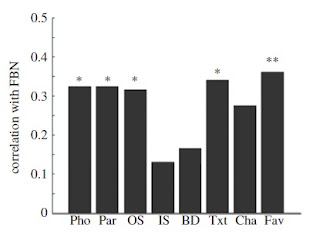You know what they say about people with big brains...
Big Facebook friends lists.
That's not entirely true.
But a new study in Proceedings of the Royal Society B has neuroscience junkies abuzz this week: the number of Facebook friends we have may be linked to certain brain structures.
Now, let's not get too worked up about this. I'll cover what we know from this study, but it's not too earth-shattering (that, or my modest brain fears being dwarfed by my more popular colleagues' extensive networks—social and neural, alike).
Current studies in social networking are growing exponentially and, in my opinion, are not money wasted. Facebook boasts 800 million active users, half of whom log onto the site everyday. Between users, these networks vary—from modest lists of close companions to scrolls of over 1,000 "friends" (come on, really?). Are these online networks correlated with real-life connections? For most, maybe—but for some, probably not. More importantly, though, do these online networks have some sort of basis in the brain?
Kanai and colleagues at University College London collected MRI scans and Facebook activity-related questionnaires from 125 individuals and noted some interesting correlations. In these individuals, the more Facebook friends they had, the denser their grey matter in three regions of the brain: left middle temporal gyrus, right superior temporal sulcus, and entorhinal cortex (a, b, and c below). Ignore the Greek: just know that these structures are implicated in memory and social perception.
Not the most convincing R value, but the correlation is there.
To make sure that the number of Facebook friends actually correlates with real-life social connections in these participants, the researchers collected some additional measures. Take my word on this: for the most part, lots of Facebook friends = lots of real-life interactions. Some of the measures were kind of LOL-able, hence my re-posting their figure:
Pho = number of friends in phonebook, Par = invitations to a party, number of friends outside (OS) and inside (IS) school, presence at a birthday party (BD), text messages received for a "celebratory event" (Txt), meetings for a chat (Cha), or number of people asked for a favor (Fav). These are all plotted to see correlations with FBN (Facebook number). The little stars denote a correlation between number of Facebook friends and that particular social measure.
This study doesn't tell us much beyond what I stated. Are people with more developed connections (namely, denser grey matter) in these social and memory-related brain areas born this way, or do they develop them over the years as their number of real-life social interactions grow?
If not, maybe we should all be putting down the books and relying on Facebook to make our brains bigger. Sounds like a safe bet to me, right?
Photos courtesy Labnol and Failbook.
Kanai R, Bahrami B, Roylance R, & Rees G (2011). Online social network size is reflected in human brain structure. Proceedings. Biological sciences / The Royal Society PMID: 22012980





No comments:
Post a Comment
I appreciate all comments and strongly encourage discussion on the topics I write about! Please be respectful to me and other readers. Spam comments will not be published.